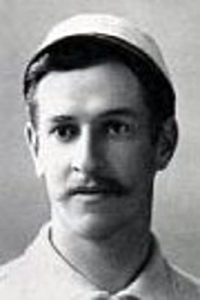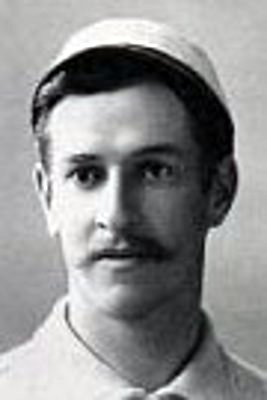April 27, 1891: Kid Nichols shuts out Phillies in Beaneaters’ home opener
 In the spring of 1891, Boston Beaneaters pitcher Kid Nichols worked out with players from the Kansas City Blues team in Kansas City of the Western Association, where he had gotten his professional start in 1887 as a 17-year-old. One of the daily newspapers reported on his prediction for the 1891 season: “He says the ‘bean-eaters’ are going to win the pennant and then he and Herman Long will come out west for a world’s championship series and show how it was done.”1
In the spring of 1891, Boston Beaneaters pitcher Kid Nichols worked out with players from the Kansas City Blues team in Kansas City of the Western Association, where he had gotten his professional start in 1887 as a 17-year-old. One of the daily newspapers reported on his prediction for the 1891 season: “He says the ‘bean-eaters’ are going to win the pennant and then he and Herman Long will come out west for a world’s championship series and show how it was done.”1
Nichols’ prophecy would turn out to be true, but his wasn’t the only optimism being felt at the beginning of the season.
The Boston Post’s buildup of Boston’s home opener on April 27 expressed hopefulness for the Beaneaters, who had swept the New York Giants in four games to start the 1891 season. New York was considered a favorite to win the pennant, so Boston gained a measure of confidence on the season’s outlook from that first series. Based on those initial games, the Beaneaters were already being characterized as a hard-playing ballclub.2
Boston manager Frank Selee managed the Beaneaters to only a fifth-place finish in 1890, his first season with them. However, part of the new optimism for the club was also attributed to their acquisition of infielders Joe Quinn and Billy Nash and outfielder Harry Stovey in the wake of the Players’ League collapse following the 1890 season.
The Beaneaters’ home opener against the Philadelphia Phillies was a festive event attended by 7,559 fans, including Massachusetts Governor William Russell, Boston Mayor Nathan Matthews Jr., and numerous other city officials, as well as several military dignitaries.3
Selee started Nichols against the Phillies. The 21-year-old right-hander had acquired his nickname because of his youth and slender build when he began his professional career.4 He had been discovered by Selee at Omaha, and when Selee got the job in Boston in 1890, he brought Nichols with him.5 As a National League rookie in 1890, Nichols became one of the starters for the Beaneaters and won 27 games. In 1891 he was paired as one of Boston’s primary starters with John Clarkson, a future Hall of Famer, and newcomer Harry Staley, who was acquired on May 27.
The Phillies had taken three of four games from Brooklyn to start the 1891 season. Manager Harry Wright used inexperienced right-hander John Thornton as his starting pitcher in this contest.
Boston wasted no time getting the scoring started in the bottom of the first when Herman Long singled to left and advanced to second on an unsuccessful pickoff attempt in which first baseman Ed Delahanty muffed the ball. Long scored on Harry Stovey’s double to the left-field fence. Thornton snuffed out further scoring by picking Stovey off at second base and then retiring the side on a strikeout and fly out.
The Phillies attempted to mount their own rally in the top of the fourth inning. After Billy Shindle fouled out, Delahanty hit a terrific drive over third base. Sam Thompson hit a groundball to shortstop Long, who let the ball get though him in an anxious attempt to execute a double play, allowing Delahanty to advance to third. Al Myers followed with another groundball to Long, who was successful in completing the double play this time and ended the threat.
Boston added a run in the bottom of the fourth inning on a couple of Phillies fielding mistakes. Stovey got a single past first base and took second when outfielder Thompson bobbled the ball. Tommy Tucker sacrificed Stovey to third base. After Marty Sullivan grounded out to shortstop Bob Allen, Quinn hit an easy fly ball to outfielder Billy Hamilton, who dropped it, allowing Stovey to score the Beaneaters’ second run.
The Phillies threatened to score again in the top of the seventh on leadoff walks to Myers and Jack Clements. But Nichols proceeded to strike out Ed Mayer, Allen, and Thornton in succession.
Boston didn’t rest on its laurels, adding two more runs in the bottom of the seventh. With two outs, the Beaneaters scored on singles by Steve Brodie, Nash, and Nichols, to build a 4-0 lead.
In the bottom of the eighth inning, Stovey hit a tremendous fly into the furthermost corner in left field for a triple. According to the Boston Post, another foot would have put the ball “over on the railroad.”6 Sullivan’s fly ball to Thompson scored Stovey.
The Phillies made one more attempt to put runs on the board in the top of the ninth inning. After Thompson grounded out, Myers hit a hard single back up the middle that narrowly missed Nichols. Clements followed with a single to left field. But then Mayer hit a groundball back to Nichols, who started a double play that squashed the potential rally and ended the game, 5-0.
Nichols pitched a solid game, yielding only five hits and three walks while striking out five. In the only three innings in which the Phillies had their best chances to score, Nichols was aided by double plays in two of the innings and helped himself in the other situation by striking out the side after allowing two baserunners. Nichols wound up winning 30 games in 1891.
The Phillies’ Thornton wasn’t hit that hard, but Boston’s hits came in bunches. He gave up four earned runs on nine hits and didn’t walk any batters. He struck out two. In its game summary the next day, the Boston Post declared that Thornton had pitched a respectable game, observing, “Thornton will surely be heard from later.”7 However, 1891 turned out to be the only full season in Thornton’s three-year major-league career. He played for several minor-league teams before retiring from the game in 1906.
The Phillies committed four errors in the game, but only Hamilton’s miscue affected the outcome.8 Boston’s Steve Brodie had one of the best defensive plays of the game when he chased down Thompson’s towering fly ball and caught it running at full speed while facing the center-field fence.9
Boston ended the season winning 18 of its last 20 games (there was one tie), including 18 consecutive winning decisions, and overcame the Chicago Colts to capture the National League pennant even though Chicago had held a 6½-game lead on September 15. Boston would claim four more league titles during the 1890s.
Was Nichols just being braggadocious before the season in his first-place prediction, or did he perhaps have some type of premonition? In any case, the team’s outstanding start to the season, including the shutout victory over the Phillies, put them on a good path that ended in winning fashion with their first National League flag since 1883.
Sources
In addition to the sources cited in the Notes, the author also consulted the following:
The source for all game details came from a box score and game summary in the Boston Post, April 28, 1891: 1-2.
Baseball-Reference.com.
Voigt, David. The League That Failed (Lanham, Maryland: Scarecrow Press, Inc., 1998).
Notes
1 Richard Bogovich, Kid Nichols: A Biography of the Hall of Fame Pitcher (Jefferson, North Carolina: McFarland & Company, Inc., 2012), 45.
2 “Boston to Open the Season with Philadelphia Today,” Boston Post, April 27, 1891: 8.
3 “Gov. Russell’s Reception,” Boston Globe, April 28, 1891: 1.
4 Jonathan Light, The Cultural Encyclopedia of Baseball (Jefferson, North Carolina: McFarland & Company, Inc., 1997), 831.
5 David Pietrusza, Matthew Silverman, and Michael Gershman, eds. Baseball: The Biographical Encyclopedia. (New York: Total Sports Illustrated, 2000), 506.
6 “Five Straight, Now,” Boston Post, April 28, 1891: 2.
7 Ibid.
8 The Boston Globe said the Phillies committed three errors in the game.
9 “Five Straight, Now.”
Additional Stats
Boston Beaneaters 5
Philadelphia Phillies 0
South End Grounds
Boston, MA
Corrections? Additions?
If you can help us improve this game story, contact us.


